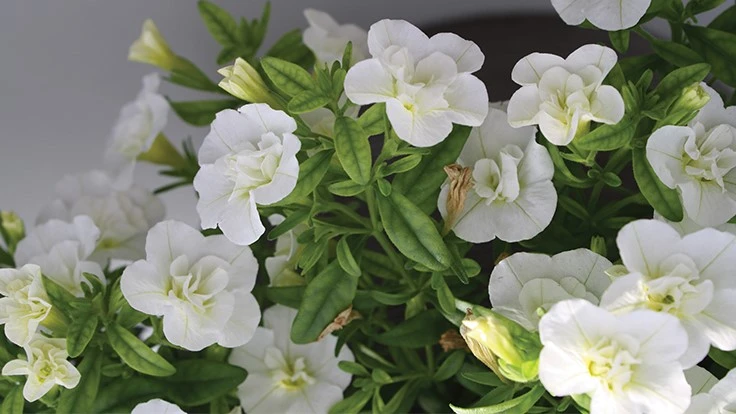

Fertilization is one of our primary considerations when we are planning crop culture and executing production. One practice increasing in popularity is reducing the concentration of fertilizer applied in the greenhouse. This is good for your crops, the bottom line and the environment. But there can be some unintended negative consequences of growing “leaner,” one of which is lower micronutrient concentrations. The vast majority of greenhouse producers use complete, balanced, water-soluble fertilizers to provide nutrients to their crops. These single-bag fertilizers have everything — macro- and micronutrients — in a single bag, and using them is a convenient way to simplify your fertilizer program. When we talk about water-soluble fertilizers, we usually refer to concentrations in “ppm N” (parts per million nitrogen). However, we need to keep in mind that when you increase or decrease your “N” concentration, the concentrations of the other nutrients change as well because the proportions of nutrients to one another are fixed; as your ppm N changes, so does everything else. While lower concentrations of some nutrients are acceptable, and even sometimes beneficial (such as lower phosphorous concentrations), lower N can result in micronutrient deficiencies. The most common micronutrient deficiency is iron (Fe) (Fig. 1.), both resulting in interveinal chlorosis on young leaves.
The first approach you may take is to increase your N concentration, thereby providing the appropriate micronutrient concentrations for your crop. However, this brings us full-circle back to the beginning of the article. The next solution to look at is to evaluate different fertilizer formulations. We can take advantage of fertilizers with varying analyses to provide different amounts of micronutrients. Let’s say we are looking at an N concentration of 75 ppm. We will look at three different fertilizers we can use to provide different levels of micronutrients at the same N concentration, each being complete, containing both macro- and micronutrients. The first fertilizer will be a standard fertilizer, 20-10-20. When this fertilizer is mixed to provide 75 ppm N in the irrigation solution, it is also delivering 0.25 ppm Fe. Now, if we switch to using a 20-10-20 Peat Lite fertilizer blend to provide 75 ppm N, there is 0.5 ppm Fe in the nutrient solution. The “Peat Lite” designation for fertilizers is an indication there are enhanced micronutrient concentrations compared to the “regular” 20-10-20. While we get two times the amount of Fe by using a Peat Lite formulation, we can still see some micronutrient deficiencies with some crops at low N concentrations. While this is a very broad generalization, a fair number of the recent vegetatively propagated genera being grown as spring bedding plants seem to have a greater micronutrient requirement, and the micronutrient concentrations of Peat Lite mixes at low N concentrations may not be sufficient. A unique fertilizer for these situations is JR Peters’ 18-2-18 Boosted Base formula, a fertilizer formulated to provide more micronutrients than Peat Lite formulations at any given ppm N. Using the same target N concentration of 75 ppm, the Boosted Base provides 1 ppm Fe. To provide the same amount of Fe using the Peat Lite or general 20-10-20 formulations, you would need to increase solution concentrations to 150 or 300 ppm N, respectively.
Selecting different complete fertilizers is one approach to achieving different micronutrient concentrations at a similar nitrogen rate. However, there is another approach you could take to customize your fertilizer — decouple the macro- and micronutrients. By having one fertilizer supplying only macronutrients and one supplying only micronutrients, you have greater flexibility in what you provide your plants. If you run your macro- and micronutrient fertilizers through their own separate injectors, you’ll have the ultimate flexibility with the ability to change concentrations of both and accommodate a wider variety of cultural requirements for your different species. There are several water-soluble fertilizers that provide complete micronutrient packages such as STEM (Soluble Trace Element Mixture; ICL Specialty Fertilizers) and MOST (Mix of Soluble Traces; JR Peters).
Reducing fertilizer saves on input costs and reduces the potential for negative environmental effects, but it may result in inadequate micronutrients being delivered to your crop. If you are trying to grow lean, but running into micronutrient deficiencies, consider some of the potential approaches presented in this article for maintaining appropriate micronutrient concentrations in your fertilizer. With the options available, whether using different single-bag mixes or a two-injector approach, you should be able to achieve your goals of reducing fertilizer concentrations without sacrificing finished crop quality.

Explore the March 2019 Issue
Check out more from this issue and find your next story to read.
Latest from Greenhouse Management
- Anthura acquires Bromelia assets from Corn. Bak in Netherlands
- Top 10 stories for National Poinsettia Day
- Langendoen Mechanical hosts open house to showcase new greenhouse build
- Conor Foy joins EHR's national sales team
- Pantone announces its 2026 Color of the Year
- Syngenta granted federal registration for Trefinti nematicide/fungicide in ornamental market
- A legacy of influence
- HILA 2025 video highlights: John Gaydos of Proven Winners





